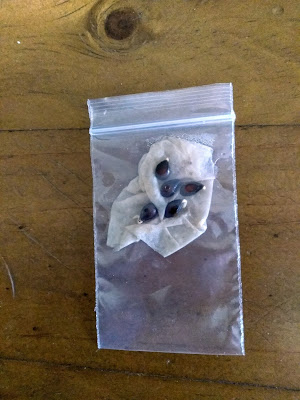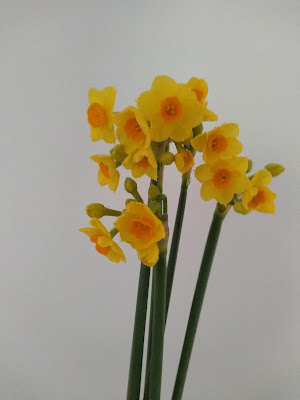I used to live on acreage and we had several hundred mixed fruit trees. Now we live in town we only have a small number of fruit trees. One is a Huonville crabapple. This is a cross between a crab apple and a domestic apple, and it has red flesh. Huonville crab is a great red fleshed apple.
I like red fleshed apples, but there are too few varieties in Australia. I tried to cross pollinate my Huonville crab with a Pink Lady apple in the hopes of a larger fruited red flesh apple that is sweeter and firmer.
I saved seeds from the apple, put them in cold wet stratification until they started to germinate. I only had five seeds, and all five sprouted.
 |
| apple seeds 01/08/2021 germinating in the fridge |
Once the apple seeds germinated I carefully planted them in a pot of soil. Then for a really long tim nothing happened, it was just a pot of soil.
It seemed like it took forever, but eventually all five seedlings popped up.
 |
| Not too long after being planted |
Even as the cotyledons were just emerging from the soil, it appeared as thought three have red leaves and two have green leaves.
The genes for red leaves is linked reasonably closely with the red flesh genes, so there is a good chance that the three red leaf plants should also have red fleshed apples. The green leaf ones may have red flesh, or they may not, there is no way to know until they fruit.
 |
| Three red leaf seedlings |
 |
| Apple tree seedlings should have been separated at this size |
I should have separated the three seedlings into individual pots at their first true leaf stage. But I didn't. I left them to grow and now they are larger.
Growing apples from seeds takes a considerable amount of time. With mature apple trees you can induce them to fruit by girdling, bending branches, and generally slowing the sap flow. Seedling apple trees are almost the complete opposite because they are in the juvenile phase.
The trick with growing apples from seed it to get as much growth as possible so they get through the juvenile phase faster. More sunlight, lots of water, fertile soil, low competition, and they should produce fruit in the lowest amount of time.
 |
| Apple tree seedlings first year |
Apple tree seedlings can take around 10 years to fruit. This timeframe can be as little as 5 years or well over 20 years depending on a lot of factors.
At this stage I don't know what to do with any of these trees. I should divide them before they break dormancy but don't know where to plant them.
Perhaps I will keep them as trees, perhaps I will graft them onto a mature tree and have them as separate branches, or perhaps I will do something else. I wish I thought of a plan for them before I grew them, but I didn't, so now I will have to think of something to do with them.

















































